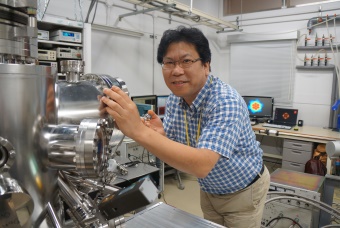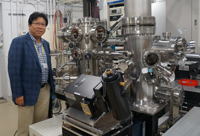Dec. 12, 2014
Probing the surface
Yousoo Kim, Associate Chief Scientist
Why is your current research important?
Studying individual molecules provides important insights into the nature and underlying quantum mechanics of chemical reactions to facilitate their control. Our research focuses on describing the energy transport and conversion that occurs on solid surfaces and interfaces in the nanoscale regime. We perform molecular- and atomic-scale studies on well-defined surfaces in ultrahigh-vacuum conditions using scanning probe microscopy and spectroscopy and density functional theory calculations.
How did you become interested in the field?
In the final year of my doctorate, I came across an impressive paper reporting the successful use of a scanning tunneling microscope (STM) to excite a single molecule bound to a solid surface and observe its vibrations. I immediately recognized that this was the kind of phenomenon I wanted to study. The STM now enables both the observation and manipulation of sub-nanoscale interfaces involving individual molecules and their interaction with atoms on a surface.
What has been the most interesting discovery in your field in the last few years?
 © 2014 RIKEN
© 2014 RIKEN
A group led by Wilson Ho at the University of California, Irvine, in the United States recently used an STM to image the chemical bonds of a molecule—often depicted as sticks connecting atomic balls. While STMs can be used to observe individual molecules, the actual chemical bonds in a molecule are impossible to image. However, by attaching carbon monoxide to the tip of an STM probe, Ho’s group developed a method that can detect tiny changes in vibrational energy in a molecule to reveal molecular bonding. We plan to use this method to characterize unknown molecules formed by chemical reactions on surfaces.
What made you decide to become a scientist?
My elder sister was a chemistry graduate student and would often perform scientific magic shows for me. These consisted of simple experiments, such as changing the color of litmus paper strips, producing different-colored flames and making ice cream without a refrigerator. Her room was decorated with a large periodic table and pictures of famous scientists. She inspired me to become a scientist even before I had graduated from elementary school.
How has being at RIKEN helped your research?
I am very proud to work at RIKEN—one of the best research institutes in the world. RIKEN has world-class scientists, a large research budget, extensive research infrastructure, and a diverse representation of research fields and nationalities. But most importantly, RIKEN facilitates communication and exciting collaborations between scientists in different fields.
My colleagues and I have developed STM-based spectroscopy techniques that have been pivotal for obtaining novel information about the origins of molecular interfaces. This might not have been realized without the outstanding facilities at RIKEN, such as the nanoscience building that provides an extremely stable and clean environment for nanoscale research.
Please tell us about your professional and personal goals.
I would like to keep my passion for science through using novel techniques to explore unknown phenomena. Personally, I strive to maintain a balance between the person I want to be, the person I should be and the person I am.

